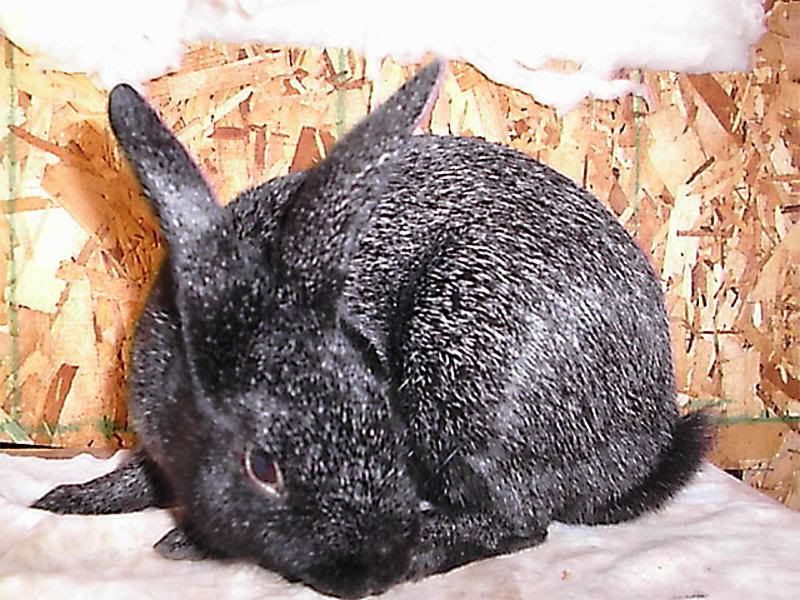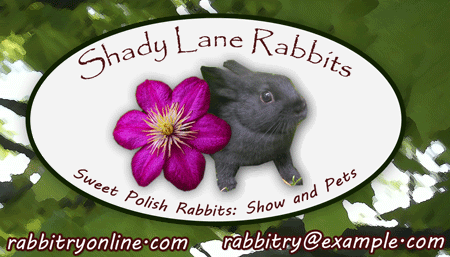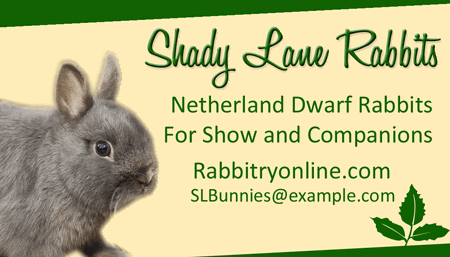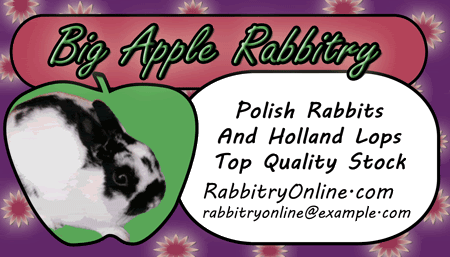
Hi Everybody! Here's a pretty cool newsletter for you this time! A friend let me republish her excellent article on choosing a good hay for your rabbits. Plus, we introduce you to one of the oldest breeds of rabbits that exists.
Hey did you see our ad in the last Domestic Rabbits magazine? It turned out bigger than I thought it would! If you haven't seen it, you can check it out on page 32.
If you scroll all the way to the bottom of this newsletter, you can find out how to get some of our popular rabbit books at half price. Also I'm offering business card designs for five dollars. Actually, I'll make it easy. Instead of scrolling, you can click here.
Until next time!
--Ellyn

I have some time this morning so let's talk about hay. I am not going to go into all the sordid details about every possible combination of hay available, but there are a few things that are important for rabbit owners to know.
#1. I have found that if someone is raising rabbits that hay will be an issue that everyone will have to deal with at some point. I know of breeders that don't include hay with their daily diet, but even then expecting does need nesting material and hay is ideal for this purpose. It is also a great choice for roughage and gives them something to do that is natural and that they seem to enjoy.
#2. There are lots of different kinds of hay available. Not all hays are equal in type or quality.
#3. Greener does not always equal better. We will talk more about this a bit later.
First for number one, I haven't talked about it much, but I have tried several long-term feeding "experiments" over this past year regarding hay. I have kept the pellets the same throughout, have avoided offering garden leftovers during this time, as well as treats. What I have found is this:
Read the rest at Hendricks Hearth >>>

What’s black on both ends and white in the middle? No, it’s not an oreo, because it walks. No, it’s not a belted cow, because it has ruby red eyes. It must be a Pointed White Bunny!
Pointed white is the name of the
color that is also sometimes called "Californian" or "Himalayan."
In this article I'll refer to the color as Himalayan, but remember that
it means the same thing as Pointed White.
CLOSE TO COLORLESS
The Himalayan color is pure white with dark “points”; that is, the nose, ears, feet, and tail are colored while the rest of the bunny is white. This is caused by a gene that is commonly called the “Himalayan gene”, symbolized by the letters ch. This is only one step above ruby-eyed white, which is why the Himalayan is nearly colorless. Color is restricted to the rabbits extremites. There's a very curious reason for this placement of the color, which we'll get to later in the article.
FUSSY ABOUT THE WEATHER
The curious thing about the Himalayan markings is that they are heat sensitive. A Himalayan that grew up in a cold climate will have darker points than one raised in a hot climate. Read the rest at
Rabbit
Smarties >>>

If I may state a humble opinion, I think that the most under-appreciated breed in the United States is the Silver. Nope, not the Silver Marten. Not the Silver Fox. The Silver.
I got my first Silvers in 2004. Since then, I have been amazed at how many rabbit exhibitors are not aware of this breed. I've seen them missing on lists of breed on different websites. Sometimes, if I mention that I raise silvers, people take it to mean Silver Foxes or Silver Martens. Those are both cool breeds, but I'm talking about something entirely different. It weighs about five pounds. It comes in three colors, each interspersed with glittering white hairs. It's built like a rock; feels like no other rabbit I've touched. Its fur is short and sleek and snappy. It's a Silver. Would you like to see one?

 A friend of mine just started a network for rabbit bloggers to get together and promote their rabbitries. Learn more and submit your rabbitry blog at www.HoppinCircle.com! |
 If you are looking to promote your rabbitry with attractive business cards, or give your rabbitry website a fresh look for the new year, I'd be happy to help you out! Prices are very affordable. Check out Graphic Design Services. |
  If you currently have a free
rabbitry website hosted at weebly.com, you can change your rabbitry
website name from YourRabbitry.Weebly.com to
www.YourRabbitry.com! Includes a free email address such as
YourName@YourRabbitry.com that forwards to your regular email.
This deal costs only $16/year. That's three times LESS than it costs to order through Weebly! Contact ellyn@rabbitsmarties.com for more information. |
 If you enjoy this newsletter or our rabbitry websites, RabbitSmarties.com and TheNatureTrail.com, your support is greatly appreciated! Feel free to forward this newsletter on to your friends, or share the links on your website. If you would like to link to the Nature Trail, you can use the button below. Thank you!  |
Despite the fact that the Silver has been known as a breed since the sixteenth century, in America today this unique rabbit is in danger of extinction. The Silver is recognized as threatened by the American Livestock Breeds Conservancy. This means that there are currently fewer than 100 annual registrations in the United States and estimated global population is less than 1,000. [Source: ALBC]
I've served as the National Silver Rabbit Club's webmaster for over six years. Seeing this club from the inside, I'm even more concerned about the future of this breed. The Silver, yes absolutely, has a following of die-hard breeders. The problem is, most of these breeders are in their 60's and 70's. I don't see much of a younger generation raising this breed. The heritage breed enthusiasts in this country are eagerly promoting rare rabbits such as the American and the Blanc de Hotot, but the Silver seems to slide under many people's notice.
So what are the differences between the three breeds with "Silver" in their name? Let's start by setting aside the Silver Marten:
The Silver Marten is easily told apart from the others by its color. While the other Silver and Silver Fox are a solid color ticked all over with white hairs, the Marten is a solid top color (without ticking) with a white (silver) belly, chest, underside of tail, insides of legs, feet, chin, nostrils, eye circles, inside of ears, and a silver triangle at the nape of the neck. It has a little silver ticking around the markings, but none over the back. A truly beautiful marking pattern, it is identical to that of the tan breed, except that the markings are white instead of red. Unlike the other two silvered breeds, the Marten color is not caused by the silvering gene, but by the tan pattern gene and the chinchilla gene. The Silver Marten has a different weight and fur then the other breeds. (The Silver Marten color is also recognized in breeds such as the Netherland Dwarf and the Jersey Wooly.)
Now let's compare the Silver and the Silver Fox.
1. Color: The Silver Fox and Silver have about the same amount of silvering, with the Fox generally having a little more. The Standard specifies an ideal amount of silvering for the Fox, where the Silver just needs calls for the ticking to be even, with no ideal heaviness given.
The base color of the Silver may be black, brown (chestnut), and fawn. Blues are also recognized in the United Kingdom. The Silver Fox is currently only showable in black; blues and chocolates are in development.
2. Type. the Silver and Silver Fox have very different body types. The Silver is smaller (4-7 pounds) and is a medium-length rabbit. It is not a compact rabbit, and is posed just sitting in a natural position, without being pushed together like must compact or commercial type breeds. The length of body and bone would make it difficult to push up a silver. The Silver still looks like the depictions of show rabbits from the 1800's! It is the only breed in this country that has retained that type.
On the other hand, the Silver Fox has a meaty commercial type. It is larger at 9-12 pounds.
3. A huge difference between the two breeds is the fur. The silver fur is one of the shortest, close-lying, snappiest coats that exists. The fur "flies back" to its normal position when stroked against the grain, faster even than on a New Zealand. On the other side of the spectrum, the Silver Fox is the only breed with a "standing" coat, that when it is stroked towards the head, it should remain as upright, as perpendicular to the body as possible, only returning to original position when flattened by a hand.
4. Temperament: Silvers are active, athletic rabbits. They need room to move around, and like to play. They may not be the best for a child, but are not aggressive. Silver Fox breeders tell me that their Foxes, however, are very low-key, just-sit-there kind of rabbits. The breed is called the "teddy bear of the rabbit world."
5. History: Sometimes I have had people ask me if the silver, since they have never heard of it before, is an unrecognized breed, or a new breed. Actually, according to Bob Whitman's Domestic Rabbits and Their Histories, the Silver was one of the very first domestic breeds, introduced to England before 1600! The book mentions Sir Walter Raleigh as their possible importer. This rabbit first appeared in the United States with the hares during the "Belgian Hare Boom" of 1900. When the forerunner of the ARBA, the National Pet Stock Association, was founded in 1910, the Silver was one of the originally accepted breeds.
The Silver Fox, while still older than many breeds, is a new breed by comparison to the silver. Developed here in America, it was accepted as a recognized breed in 1929. It's believed that the first Foxes were crosses of American Blues and Champagne D'Argents (which were developed from silvers).
All the silvered breeds are different, all are unique. All can be fun to raise. But the slogan of the National Silver Fox Rabbit Club could be used for each breed (with a date change):
"ONE OF A KIND since 1929!"
Notes:
The Silver breed as we know it is recognized in only one other country, the UK. However there are about 15-20 different breeds with silvering around the world.
The Silver Fox breed is not known outside of the US. However, the breed/color known as "silver fox" by British standards is the same color as our "silver marten."
There are actually 4 breeds showing the silvering gene that are recognized by the ARBA: the Silver, the Silver Fox, the Champagne d'Argent, and the Creme d'Argent.
Links to breed specialty club websites:
Silver: www.silverrabbitclub.com
Silver Fox: http://www.nsfrc.com/
Silver Marten: http://www.silvermarten.com
Champagne d'Argent: none
Creme d'Argent: http://www.cremedargent.org/
I have about ten slightly-imperfect copies of my two most popular rabbit books: The Youth Rabbit Project Study Guide, and "A Practical Breeder's Guide to Rabbit Coat Color Genetics." The books are completely fine except that the color is tinted slightly to magenta on the Study Guides, and slightly to blue on the Color Genetics books. They are still entirely usable and readable, I just don't want to sell them at full price.
Both books normally retail for $20 but I am offering these copies for $10 each, plus $3 shipping inside the US. If a 4-H club wants to buy them all in a package deal, I can give you even a better price. Let me know at ellyn@rabbitsmarties.com if you are interested and I can help you get the discount.
Click the covers for more information:


When I do a biz card design for someone I send them multiple designs to choose from. The result is that I end up with a lot of extra unused designs. These are NOT resales - these are unused designs. So if anyone wants one of these, it would be just $5. Will customize for your info, of course, and can switch out the rabbit with one of your pics. I can do a new custom design as well for $20. Contact me at Design@RabbitSmarties.com
 |
 |
 |
 |
  |
 |
 |
 |